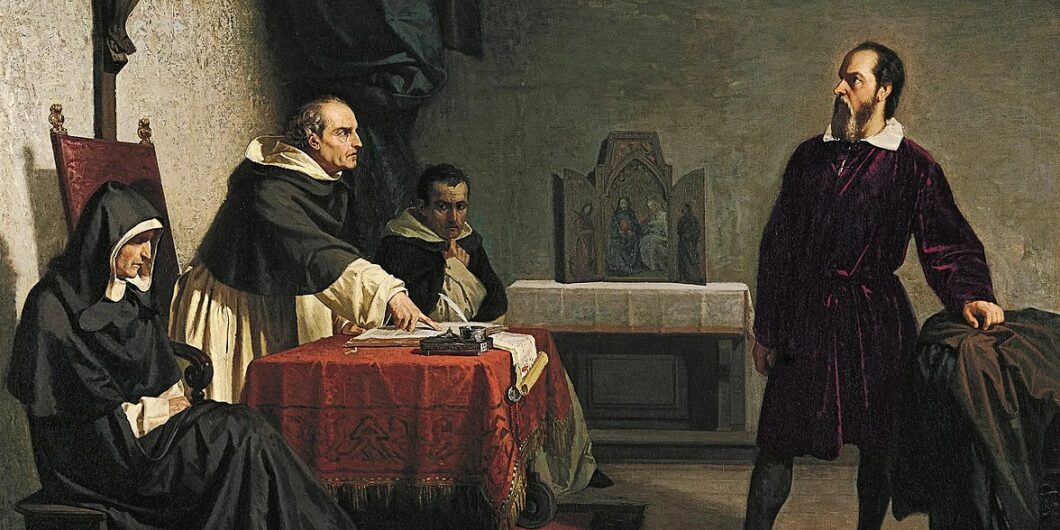Activists often claim a kind of sacred wisdom about transgender issues. But in the UK, at least, that's now up for debate.
Science Between the Sacred and the Profane
It’s a familiar trope of popular history: the heroic rise of science and Enlightenment, emerging sometime around the eighteenth century from a miasma of religious obscurantism, in the teeth of clerical opposition. While it contains a kernel of truth, Nicholas Spencer demonstrates this narrative relies upon numerous historical myths, regularly recycled to traduce traditional Christianity and the imagined credulity of religious people in general. From the trial of Galileo in the seventeenth century to the Scopes Monkey Trial in 1925, Spencer debunks a litany of popular misconceptions and shows that the historical relationship between science and religion is not the morality play that is often depicted. In the process, he touches upon themes of fundamental importance to the evolution and future of the West—notably, the location of cultural and legal authority, and the shifting nature of sacred values.
Magisteria is neither an apologia for the Church nor an attempt to rehabilitate its scientific credentials. Spencer does not shy away from episodes where Protestant and Catholic authorities persecuted scientists and freethinkers in the service of blinkered reaction, and he reveals that apparently benign efforts to read scientific orthodoxy into scripture were both intellectually dishonest and frequently counterproductive. Changing scientific paradigms caused mounting problems for religious doctrines that had been reconstructed according to the scientific knowledge of earlier times.
Still, Spencer is sympathetic to both the religious and scientific outlooks and upholds a liberal tradition that appreciates the unique contribution they each make to human wellbeing. Magisteria shows not only that science and religion have not always been in conflict, but that religion was often the midwife of scientific discoveries. Sir Francis Bacon’s promotion of the experimental method, for example, was inspired by his Protestant understanding of the Fall: our cognitive abilities being as damaged as our moral and spiritual ones, humans could not think their way to the truth, but should use observation, experimentation, and experience to slowly approximate their way in that direction. This vision of science was based on knowledge of human frailty and on humility, rather than hubris.
The book’s title is a nod to paleontologist Stephen Jay Gould’s claim that science and religion constitute “non-overlapping magisteria,” whereby science pertains to the empirical realm of facts, and religion to ultimate meaning and moral value. According to Gould, if both “magisteria” are properly understood, and keep to their respective lanes, the potential for conflict will be minimised.
Gould’s scheme is not without appeal on moral or intellectual grounds, and Spencer is open to its humane and peaceable intent. Nevertheless, he points out that it is ultimately unsustainable, due not least to the stubborn refusal of real-life actors to adhere to the theoretical boundaries Gould demarcated.
Through a series of case studies, Spencer searches for a pattern in the tension between science and religion, proposing two main sources. One is authority, which has always been a “lightning rod” for disagreement: “Who has the right to pronounce on nature, the cosmos, and reality?” The second source is “the nature and status of the human.” Humans are both material and spiritual beings, meaning scientists and theologians each claim us as their “turf.” There is probably no getting away from this, Spencer concluding that “Science and religion are partially overlapping magisteria, and they overlap within us.”
Spencer explains that Gould’s NOMA was conceived partly in response to the disciplinary overreach of buccaneering sociobiologists and evolutionary psychologists who, in the late twentieth century, sought pseudo-scientific explanations for all aspects of the human condition. The metaphor of a historical “war” between science and religion was grist to the mill for this latter-day anti-clericalism, which peaked with the New Atheism of the 2000s. Yet most of the intellectual controversies engendered by that movement now seem rather quaint, having long been overtaken by other concerns. Science and the Enlightenment have themselves come in for harsh treatment from progressive critics due to their connections with colonialism or other historical evils (some of which are recounted here).
Without idealising European history, Spencer’s refreshingly charitable approach means we encounter intellectual and religious diversity, rather than undifferentiated misery, bigotry, and superstition. He shows, for example, why differing attitudes towards Aristotle had meaningful consequences for the course of Protestant versus Catholic science; and the implications of theological sensitivities for the relative success of chemistry or Cartesian philosophy in different countries.
Intellectual titans such as Bacon and Charles Darwin occupy a key place in this book’s narrative. But Spencer also writes engagingly about lesser lights of cultural history, such as eighteenth-century philosopher David Hartley, who proposed a material basis for spirituality within human physiology. Suggesting that memories and ideas could all be traced to sensory vibrations, Hartley’s original scheme “married material, mechanical, moral and spiritual in unprecedented harmony.”
A creative and unconventional thinker, Hartley was also a devout Christian, and his ideas might easily seem eccentric and inscrutable to many modern readers. Yet Spencer is adept at explaining the imaginative worlds of previous centuries when religion was an immediate and pervasive presence for most people and explicitly constituted their mental outlook. Indeed, while Magisteria is a work of secular history, its author harnesses the tools of modern scholarship while maintaining a more than scholarly interest in religion. This helps him write insightfully about diverse historical figures, united by their Christian faith and their passion for science.
Spencer explains that clerical authorities have often been suspicious about scientific experimentation, and even about human curiosity itself. But the vehemence of the conflict between science and religion commonly varied according to the importance of what was being studied within the prevailing value system. This is why, Spencer observes, physics has usually been less contentious than biology: physics had less to say about human nature.
As the history of science and religion shows, sacred values can change over time. But changes should be organic and in keeping with the evolved habits and preferences of the population.
Over the centuries, the principle of free inquiry saw scholars question the teachings of tradition and revelation in ever-wider fields. From the late nineteenth century, free inquiry came to encompass the study of religion itself. Spencer considers several influential figures in this tradition, including Sir James Frazer and Sigmund Freud. Yet he doesn’t mention their contemporary Émile Durkheim, perhaps the most important figure in the sociological study of religion. This is unfortunate: Durkheim’s perspective permits a parsimonious explanation that reveals conflict between science and religion as part of a wider balancing act within human affairs, between the profane and the sacred.
Durkheim defined religion as “a unified system of beliefs and practices relative to sacred things, that is to say, things set apart and forbidden.” This predicts conflict whenever scientists attempt to study sacred things “set apart and forbidden”—whatever they might happen to be—and, in so doing, challenge religious taboos. This includes fundamental questions about human nature, because this is sacred in most cultures. Today, stem cell research, human cloning, or assisted dying invoke some of the same deep-seated taboos as heliocentrism or the evolution of man once commonly did.
However, it’s not just theistic religions that generate sacred ideas; and science can threaten taboos that are completely unrelated to human nature. Many ostensibly secular and even “scientific” institutions have propounded establishment dogma and punished heretics. Spencer explains how official Soviet science rejected evolution by natural selection as incompatible with Marxism and promoted the cult of biologist Trofim Lysenko, with devastating consequences for agricultural production. Spencer notes that “it might almost look as if it were ideology in general, rather than religious ideology specifically, that had a deleterious effect on science.”
Of course, science is never conducted in a vacuum, independent of wider societal values. But there is an important difference between sacred and non-sacred values. While the latter can be “traded” incrementally against other things, sacred values tend to be considered absolute. The default position of most cultures across history has been to mandate compliance with majoritarian values, ultimately by violence. The modern West has been an exception to that rule, evolving processes and institutions which balanced authority with liberty, and allotted greater leeway for individuals and minorities to cultivate their sacred values and preferences within an increasingly pluralist culture. Countries that preserved processes such as free speech and the rule of law generally became more tolerant, liberal, and permissive, to the point that after World War II, the West could confidently style itself “the free world.” For many, freedom itself came to define the West.
Yet liberal permissiveness also provides opportunities for moral entrepreneurs to impose new sacred values upon society. For most of the last century, moral absolutism in Britain and America was associated with the religious right. Recently, it has been chiefly associated with the progressive left. Some commentators have suggested that the West’s “culture wars” represent a response to the left’s embrace of new sacred values, especially concerning race and gender. John McWhorter, for example, has criticised the new “religion of anti-racism,” while Eric Kaufmann has defined being “woke” as the “sacralisation” of historically marginalised identity groups.
Activists who insist that Western democracies observe their sacred values generally make little or no allowance for the traditions, customs, or preferences of the majority. They are most successful when politicians and administrative elites are receptive to their agenda (as with race and gender ideology), or lack the moral wherewithal to oppose de facto imposition of taboos through bottom-up “emergent authoritarianism.” Their demands have encompassed everything from pronouns to home insulation—revealing humanity’s extraordinary capacity to imbue almost anything with sacred meaning.
Private citizens may lament such developments, but they are usually prepared to “trade off” their non-sacred values, withdrawing from conflict until something they personally hold sacred is affected. For most people, nothing is more sacred than their own children. In a historical example with topical resonance, Spencer notes that some of the controversy over evolution stemmed from how it was being taught in schools. “Debating the arguments and implications of evolution among consenting adults was one thing; teaching it as unambiguous truth to the children was quite another.”
As the history of science and religion shows, sacred values can change over time. But changes should be organic and in keeping with the evolved habits and preferences of the population. They should also involve an open and inclusive process of negotiation, rather than being introduced by administrative fiat. Rapid and artificial change risks provoking conflict between sets of sacred values—something with much greater destructive potential than conflicts between science and religion.


